Amazing photos of the planet's most colourful natural wonders
The rainbow Earth

Serjio74/Shutterstock
Our planet and its natural beauty are simply jaw-dropping. From hot springs and salt pans to mountains and ice caves, the world is filled with awe-inspiring natural wonders bursting with colour. Here we've rounded up some of the most striking and vibrant sights on Earth – to enjoy these photos at their best, be sure to view them in full-screen.
Read on to discover the natural world's most colourful spectacles...
Fly Geyser, Nevada, USA
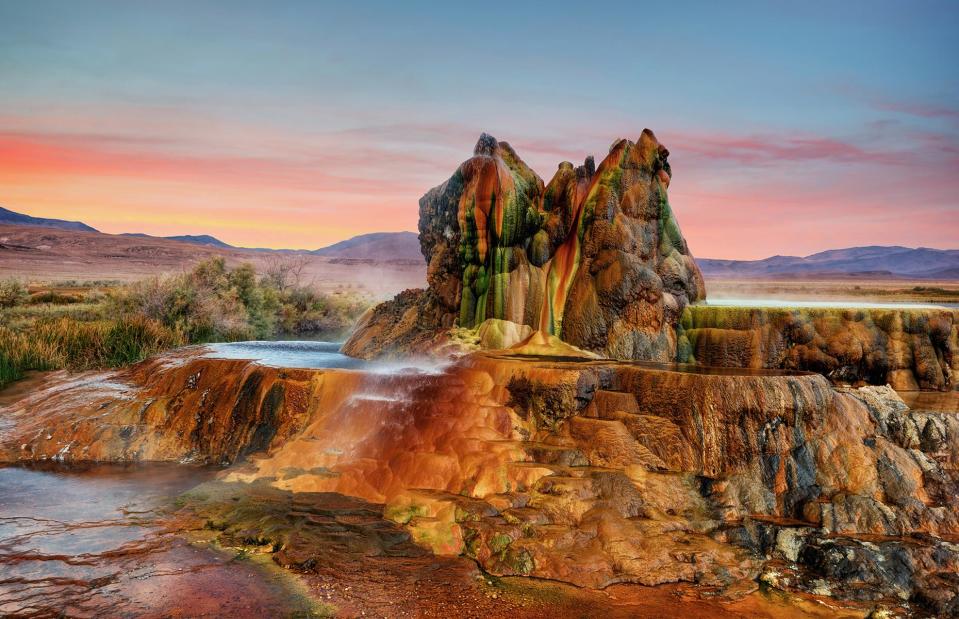
Lukas Bischoff Photograph/Shutterstock
The kaleidoscopic Fly Geyser in Black Rock Desert is a totally unique sight as it was actually formed due to human error. In the 1960s, a geothermal energy company drilled on the site in the hope of striking a usable power source. The water the workmen hit wasn't warm enough but they failed to properly seal the opening they made. Today, the geyser still spews water and steam, and the brilliant colours are formed by the algae that covers it.
Landmannalaugar, Iceland
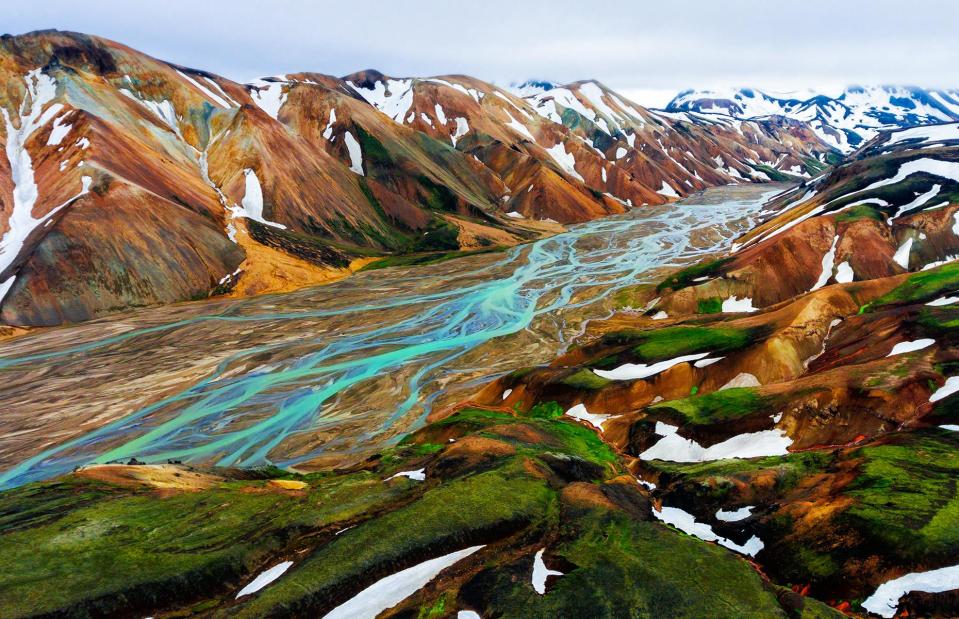
Blue Planet Studio/Shutterstock
The Highlands of Iceland are renowned for thermal springs and mirror-like fjords, but Landmannalaugar is unlike anywhere else in the world. Inside Fjallabak Nature Reserve on the edge of the Laugahraun lava field, this unique and unusual landscape was formed during a volcanic eruption around 1477. Famed for its geothermal springs and azure rivers, this rugged region also benefits from candy-coloured hills that appear to be painted by hand.
Mendenhall Ice Caves, Alaska, USA
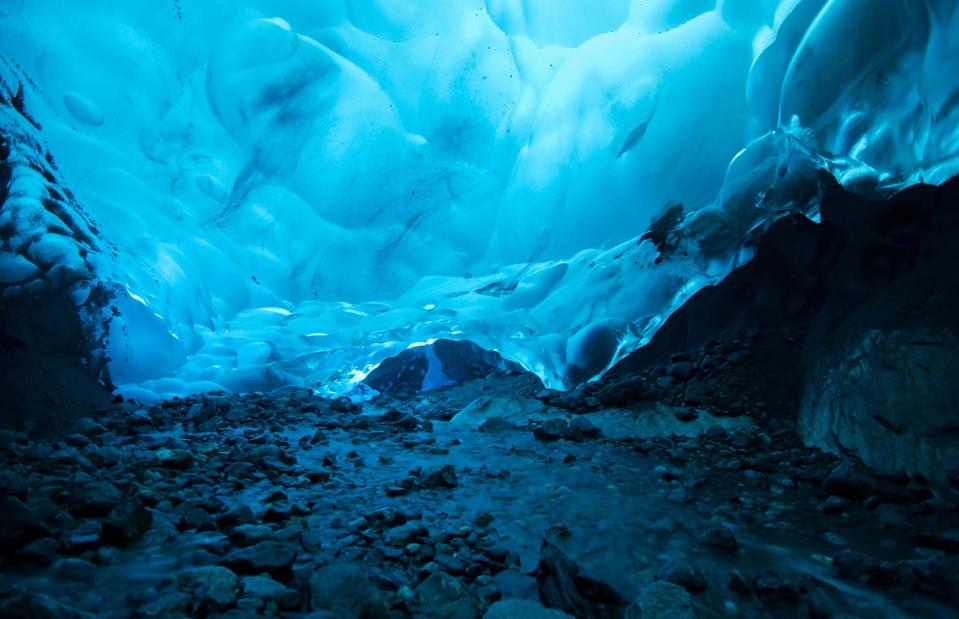
Taylor McKnight/Shutterstock
Equal parts eerie and enchanting, these ice caves can be found less than 12 miles (19km) away from the city of Juneau in Alaska. Deep inside the Mendenhall Glacier, the tunnels were carved out by melting ice and the flow of water around the side of the glacier itself. As light penetrates the clear ice, it gives the caves a strikingly dark and deep blue colour.
Yuanyang rice terraces, Yunnan, China
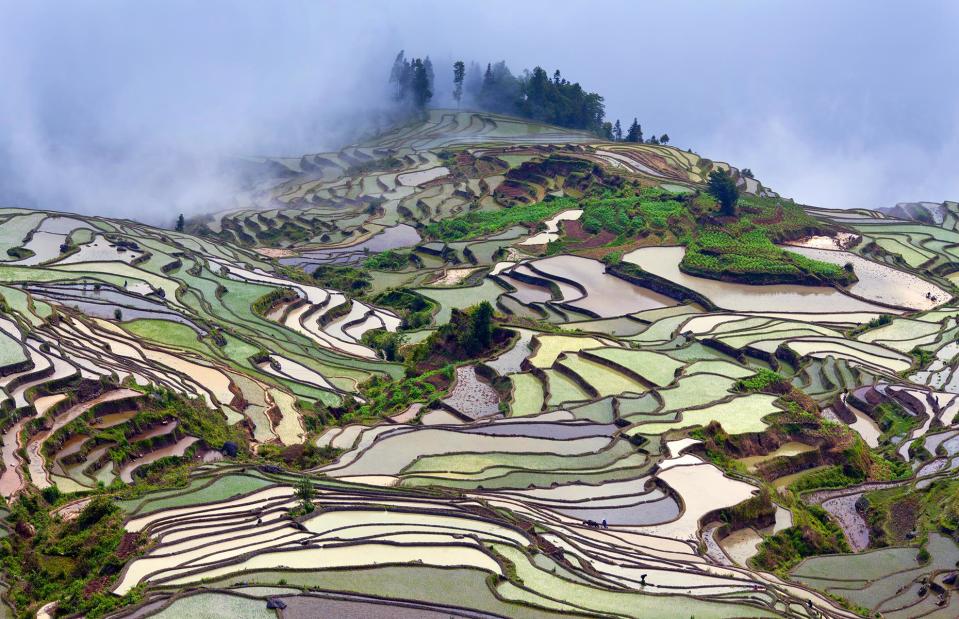
Zzvet/Shutterstock
These vibrant rice terraces in China's Yuanyang County have been a UNESCO World Heritage Site since 2013, and no wonder. Built on red-soil mountains over 2,500 years ago and reaching up to 6,561 feet (1,999m) above sea level, the rice terraces fill with cascading spring water from the forests above, creating a unique scene in shades of green and brown.
Lake Louise, Alberta, Canada
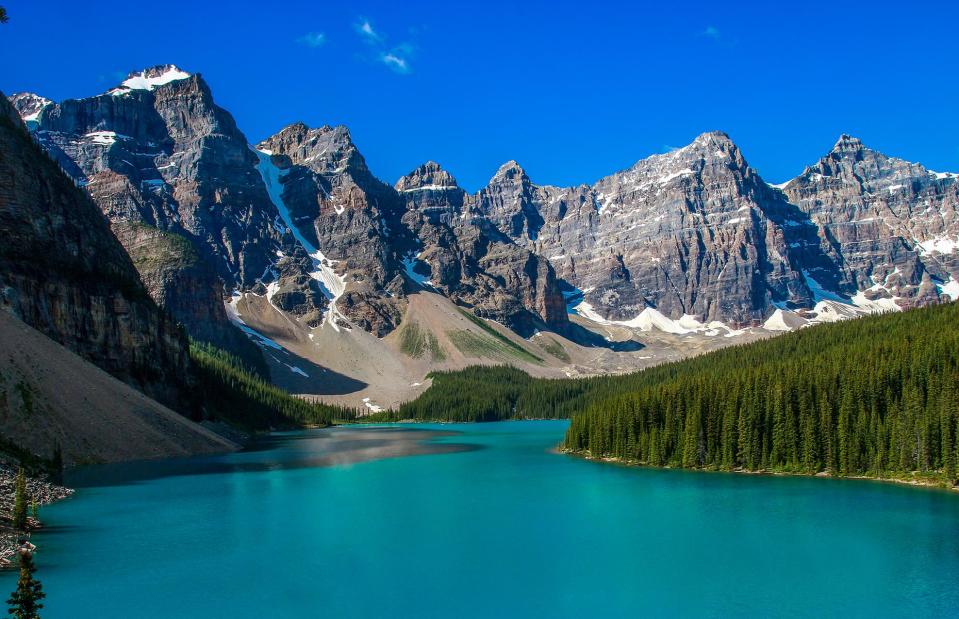
Club4traveler/Shutterstock
Lake Louise is the most famous of Banff National Park’s turquoise lakes, which include Moraine Lake and Peyto Lake. The lakes get their distinctive blue colour from reflective glacial silt that makes its way into the water. The ice-cold glacial water also makes them too cold for swimming, even in summer.
Cano Cristales, Colombia
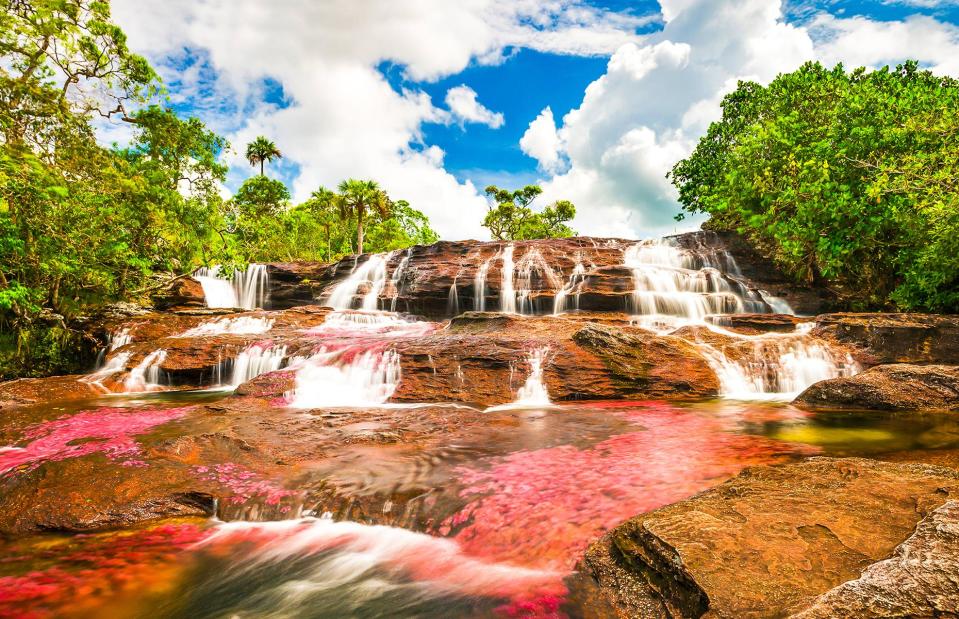
VarnaK/Shutterstock
Within the Sierra de La Macarena National Natural Park in Colombia, this exquisite river is aptly nicknamed the River of Five Colours. Cano Cristales is considered one of the most beautiful waterways in the world, and for several months each year it dazzles with interchanging hues of pink, green, yellow, blue and black. This natural display occurs thanks to an endemic aquatic plant that changes colour when exposed to sunlight.
Palouse, Washington, USA
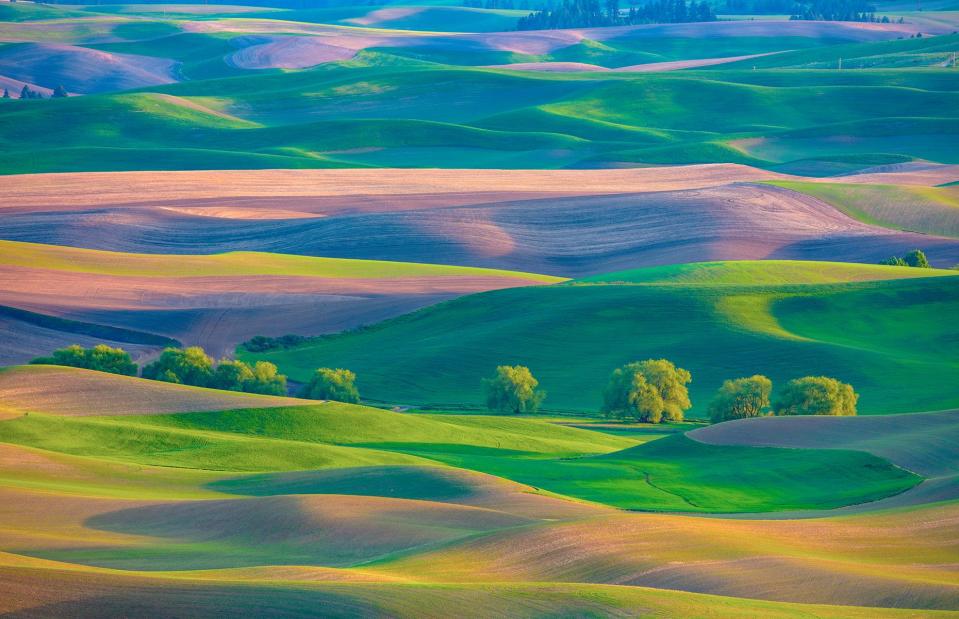
Alex Donnelly/Shutterstock
Despite being one of America's most attractive regions, the Palouse often slips under the radar. This major agricultural area, which also encompasses parts of Idaho, is known for picture-perfect pastoral fields that shimmer in shades of purple and green. These idyllic hills were formed over tens of thousands of years from wind-blown dust and silt from drier climes.
Zhangye National Geopark, Gansu, China
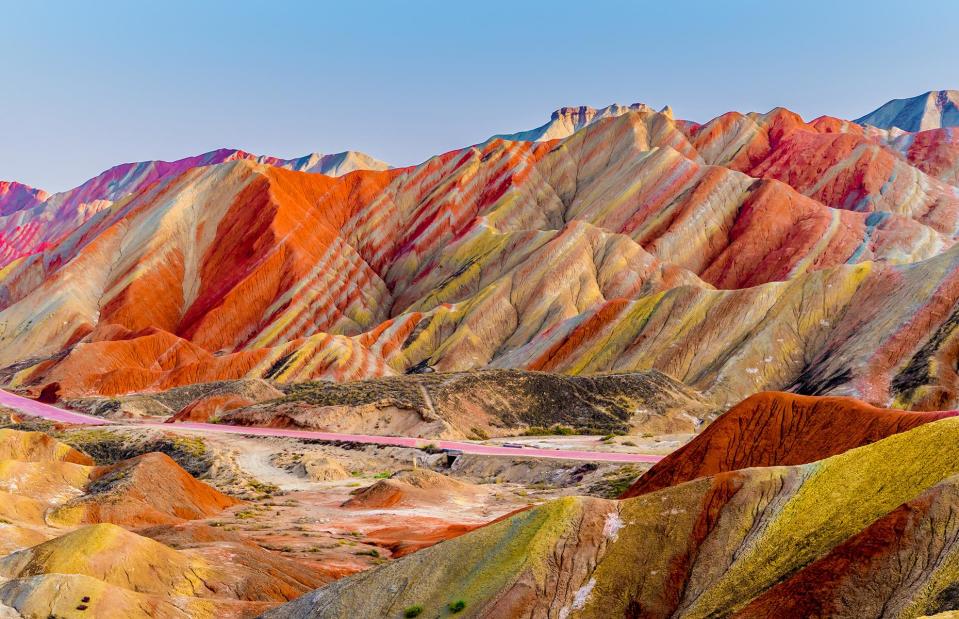
THONGCHAI.S/Shutterstock
The rainbow-hued mountains in Zhangye National Geopark look just like an artist's brush strokes. Part of a UNESCO World Heritage Site, this stunning formation was created by natural erosion, when layers of sand, silt, iron and minerals blended together to create a kaleidoscope of colours. The incredible park appears to have been decorated by Mother Nature herself.
Batad and Banaue rice terraces, Philippines
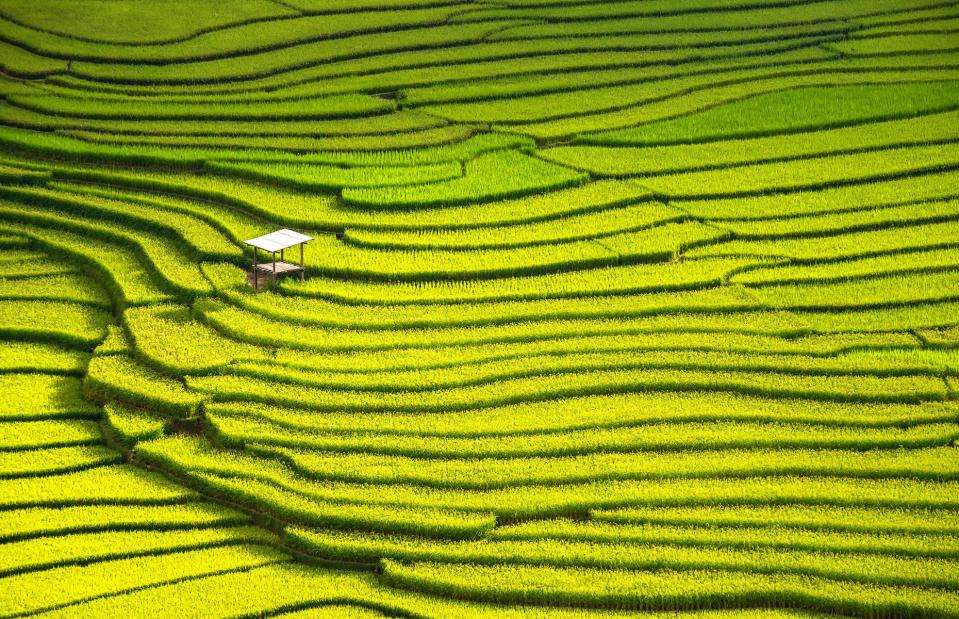
martinho Smart/Shutterstock
Hand-carved into the mountains 2,000 years ago, the rice terraces in the Philippines’ Ifugao province are staggeringly spectacular. There are five vast, UNESCO-listed terraces stretching hundreds of feet into the air. Local lore has it that if you joined all the terraces end to end, they’d reach halfway round the Earth. They are at their most beautiful in late spring when the young rice gives the terraces a lush green colour.
Lake Hillier, Western Australia, Australia
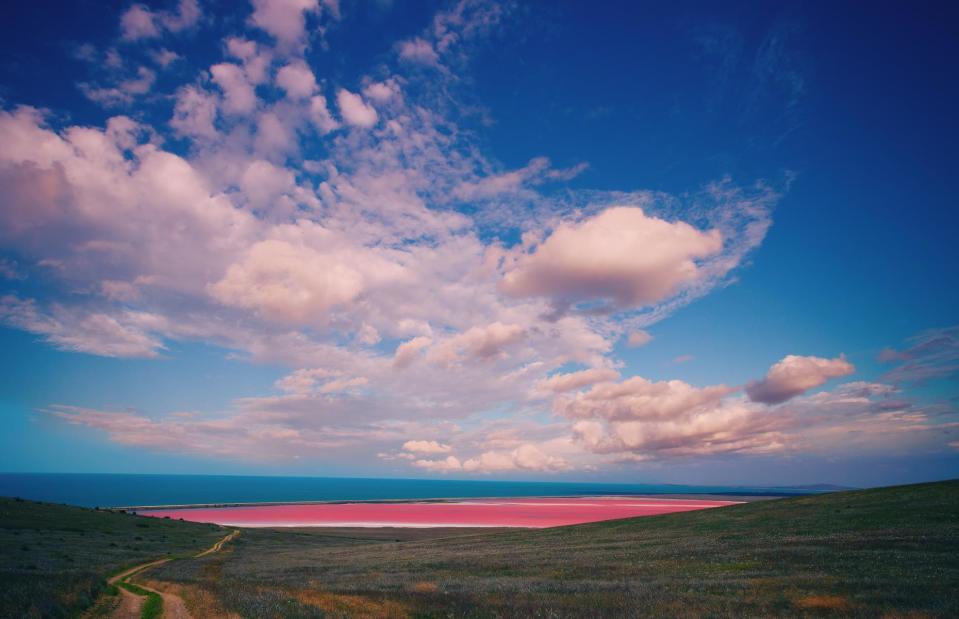
Vvvita/Shutterstock
Australia’s natural wonders come in a kaleidoscope of colours, including bright pink. The pretty-hued Lake Hillier can be found on Middle Island in Western Australia’s Recherche Archipelago, around 70 miles (113km) from Esperance. Framed by green forest and blue water, it’s an extraordinary sight. It’s not certain exactly why the water is pink but it’s thought to be related to its high salt levels.
Provence in summer, France
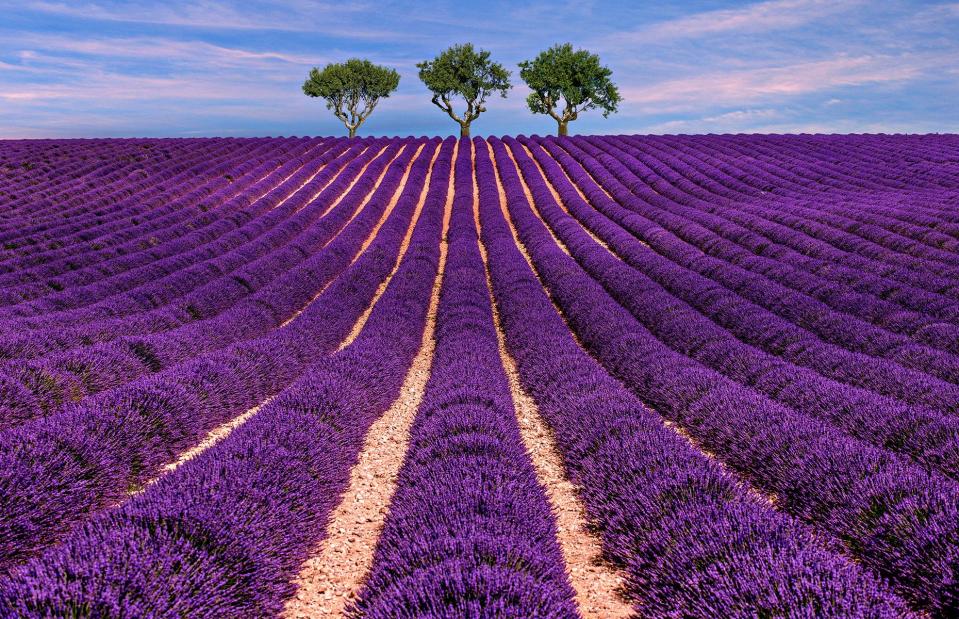
ER_09/Shutterstock
The lavender fields of France's Provence region explode in a fragrant haze of purple from around mid-June up until August (though they're at their peak in early July). The largest concentration of lavender fields is on the high plateau around Sault, at the foot of Mont Ventoux and around Apt and Gordes. Lavender is an important part of life in Provence as it has countless uses, from beauty products and soaps to aromatherapy, as a natural remedy and even in cooking.
Seven Coloured Earths, Mauritius
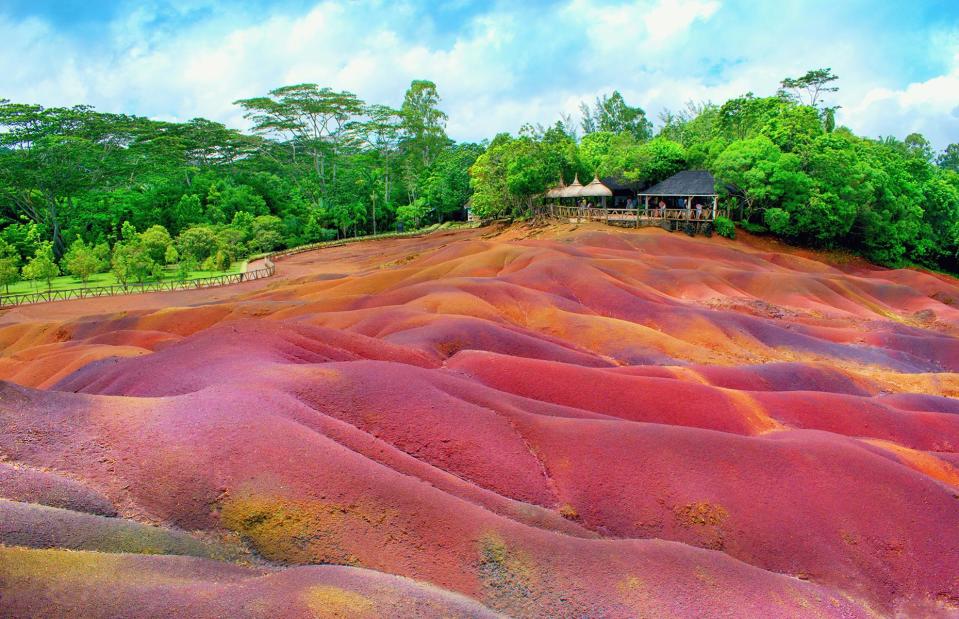
Tunatura/Shutterstock
The most famous natural wonder on Mauritius, the Seven Coloured Earths are colourful sand dunes surrounded by a dense tropical forest. The dunes were created as basaltic lava gradually transformed into clay minerals, and due to various cooling temperatures of the rock, resulted in seven different colours. True to the name, the dunes are red, brown, violet, green, blue, purple and yellow.
Painted Hills, Oregon, USA

Josemaria Toscano/Shutterstock
You'll have a hard time believing that these colour-splashed mountains are real. With distinct lines of red, yellow, orange and black, these hills show how the region's climate and geology have changed over time. Part of John Day Fossil Beds National Monument, the hills are listed as one of the Seven Wonders of Oregon.
Great Barrier Reef, Queensland, Australia
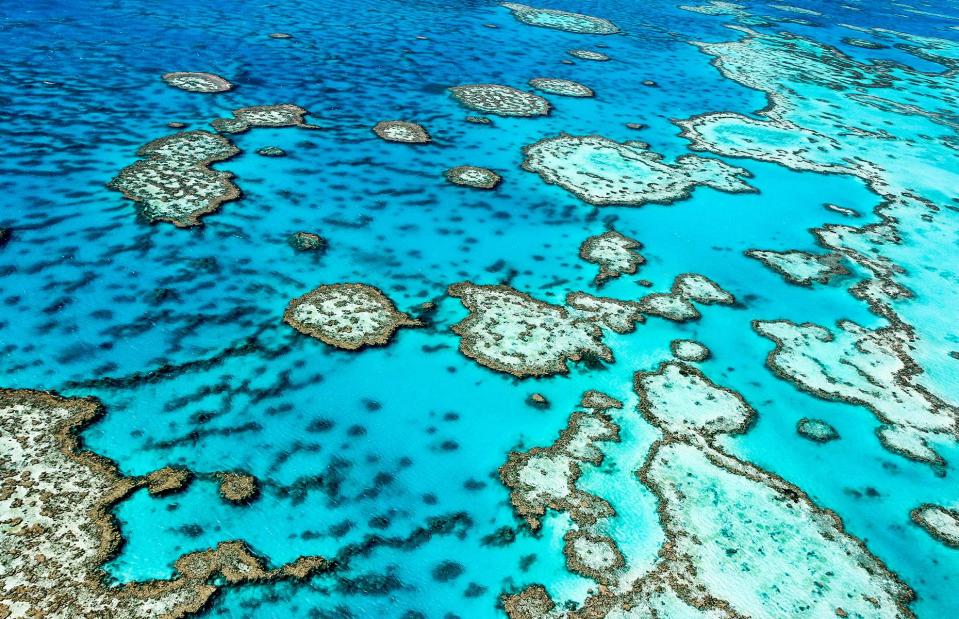
Edward Haylan/Shutterstock
The Great Barrier Reef is famously so vast it can be viewed from space. It’s the world’s largest reef system, made up of nearly 3,000 reefs, and is the world's biggest single structure made by living organisms. It’s also home to whales, dolphins, sea turtles and thousands of species of fish. Even without all that, the dazzling, dappled expanse of blue is pretty lovely to look at.
Laguna Colorada, Bolivia
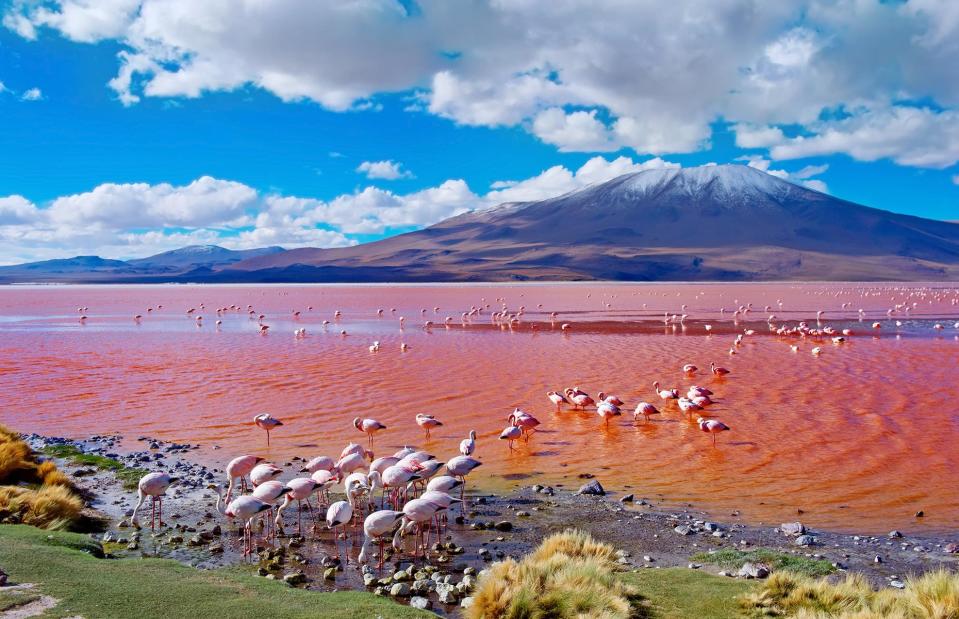
Belikova Oksana/Shutterstock
Located high up in a natural reserve close to the Chilean border, this shallow, red salt lake is considered to be one of Bolivia's most beautiful natural landmarks thanks to its striking appearance and the large flocks of flamingos that hang out there. The water gets its unique colour due to red sediments in the water and the pigmentation of some algae.
Five Flower Lake, Sichuan, China
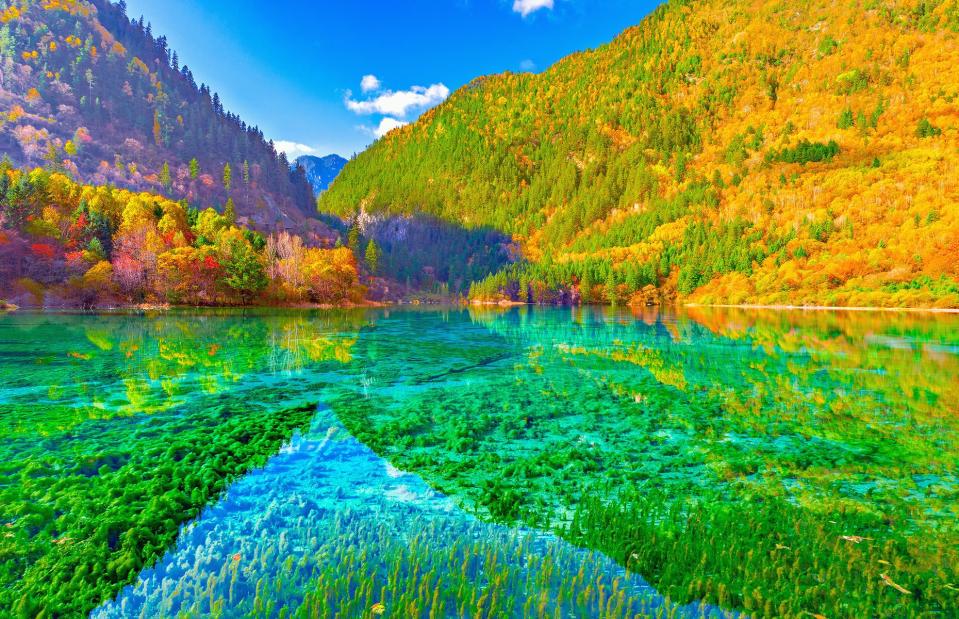
Serjio74/Shutterstock
China's Jiuzhaigou Valley is on the UNESCO World Heritage List for very good reason, and Five Flower Lake is perhaps its most dazzling feature. This serene lake is considered holy by many locals thanks to its interchanging colours and the fact that it doesn't freeze, even in winter. Yet the mystery behind this unique wonder can be easily explained – home to hot springs, the pool also has aquatic plants which change colour when exposed to sunlight.
Rainbow Mountain, Peru
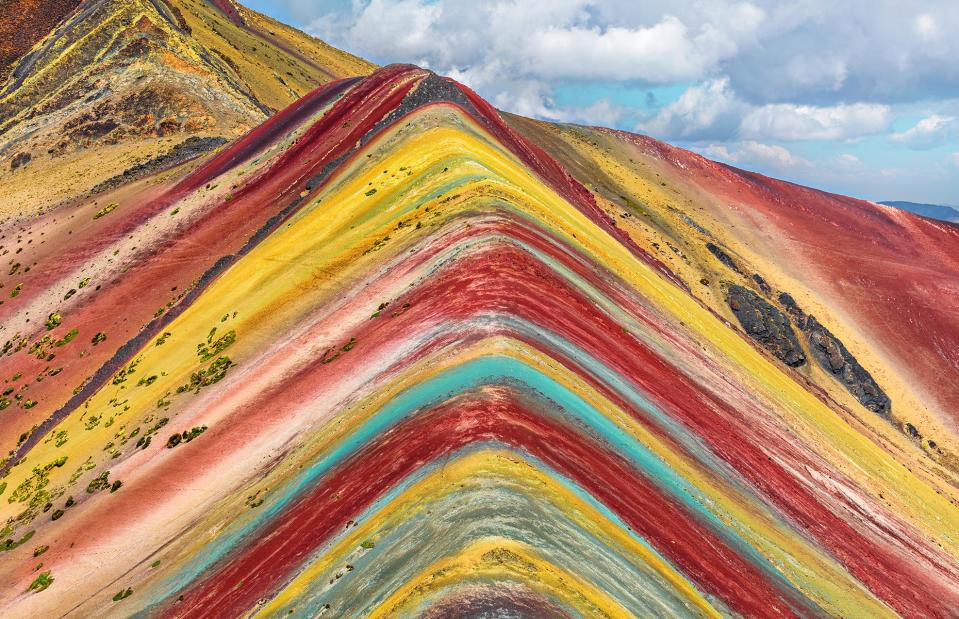
May_Lana/Shutterstock
This multicoloured mountain in the Peruvian Andes is not man-made, despite what its perfectly symmetrical layers might make you think. The colourful bands, ranging from pink and red to yellow and green, are the result of sedimentary layers forming from mineral deposits over the years.
Na Pali Coast, Hawaii, USA
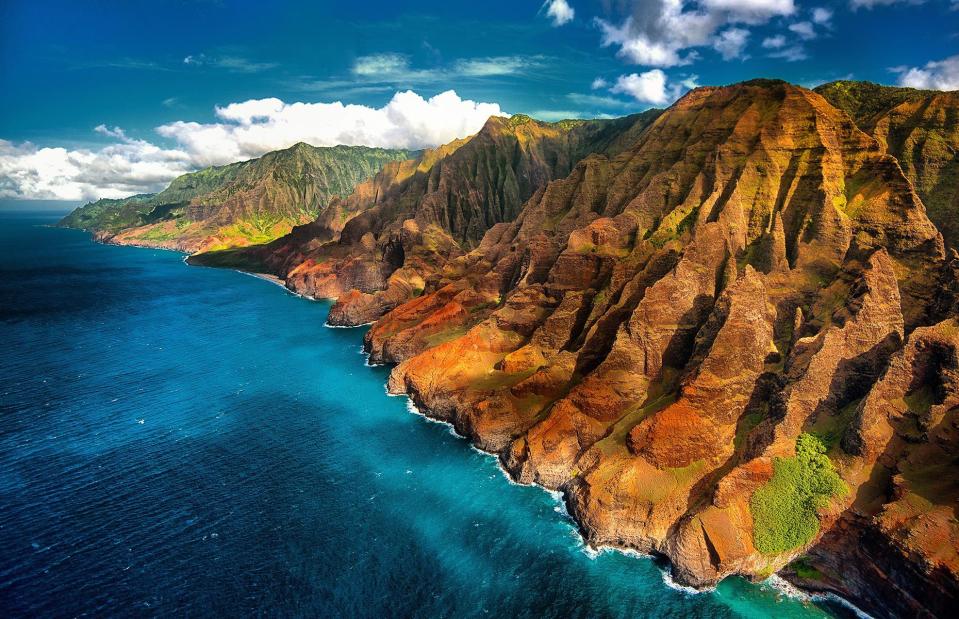
Mohamed Selim/Shutterstock
The gorgeous forest-covered cliffs of the Na Pali Coast State Wilderness Park on Kauai Island are an exquisite sight to see. Like something straight out of Jurassic Park, some of the rugged red and green rocks of the coast look more suited to a different planet than Earth. Na Pali means high cliffs in Hawaiian – a very fitting name when the tallest mountains here soar to 4,000 feet (1,219m).
Marble Caves, Chile
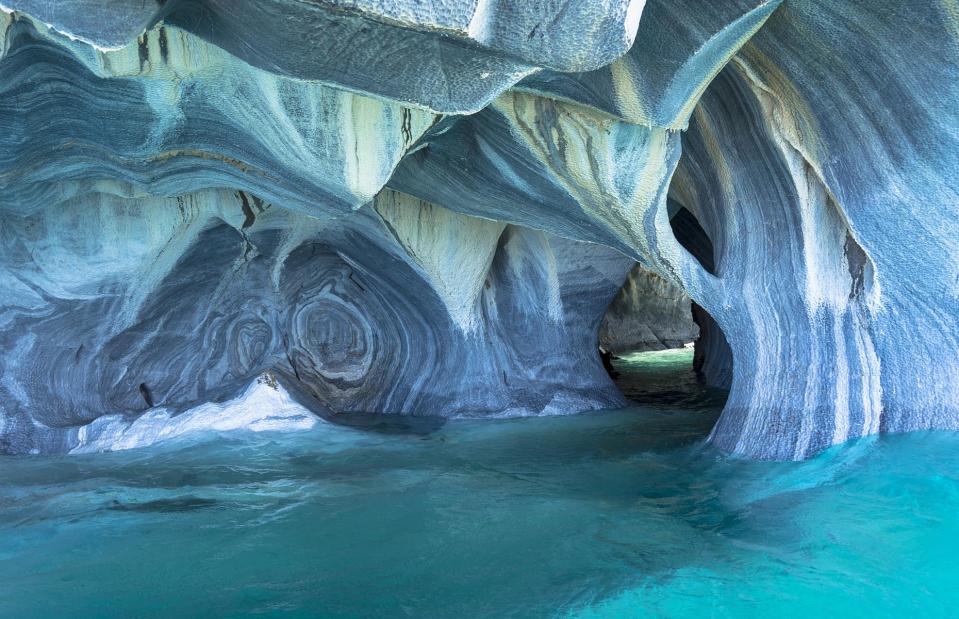
San Hoyano/Shutterstock
Waves crashing into solid calcium carbonate for 6,000 years created Chile’s incredible Marble Caves, locally known as Capillas de Marmol. Their swirling blue pattern changes colour and intensity throughout the year. Located in the middle of Lake General Carrera, the caves are one of the most isolated treasures in the natural world.
Rio Tinto, Spain
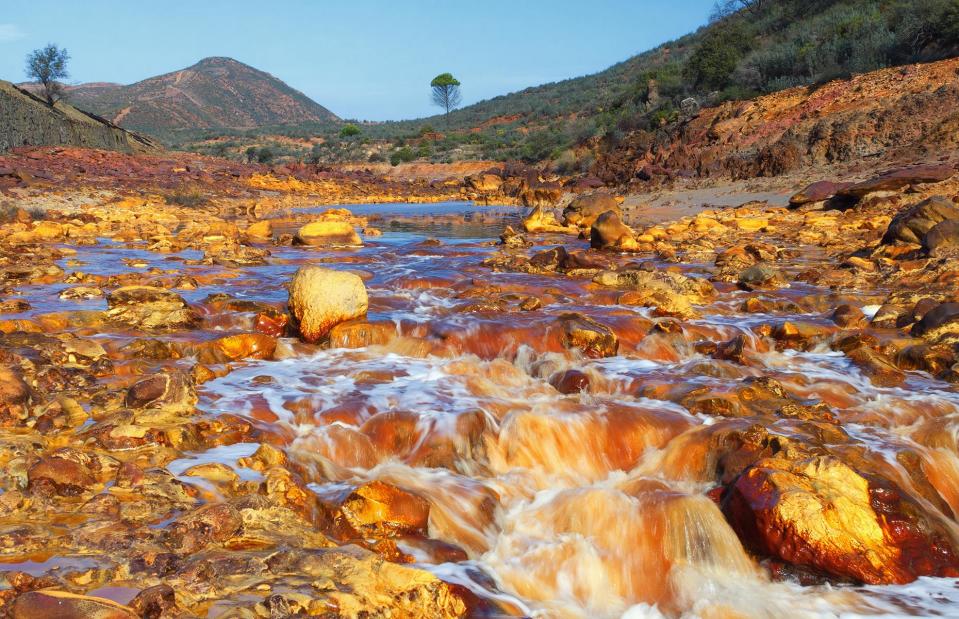
Jose Arcos Aguilar/Shutterstock
Flowing through southwestern Spain, from the Sierra Morena mountains in Andalucia to the Gulf of Cadiz, this strikingly coloured river resembles wine more than water. Its unique red and orange pigmentation is caused by an intricate chemical makeup of very high levels of iron and heavy metals. However, it's not clear how much of the high level of acidity in the river has come from natural processes and how much is from ore mining in the area.
Huay Mae Khamin Waterfall, Thailand
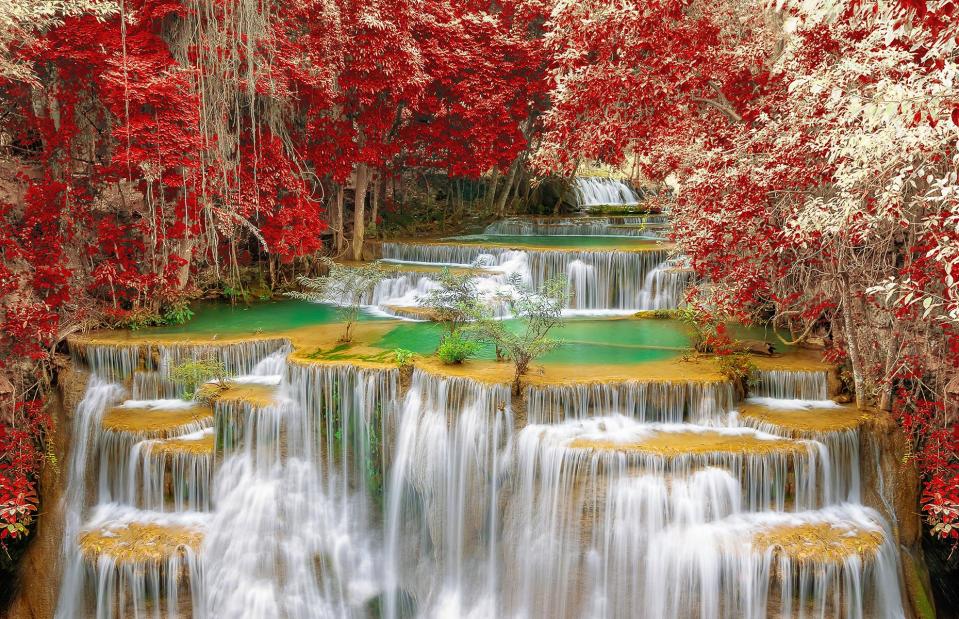
24Novembers/Shutterstock
This breathtaking natural wonder is considered one of Thailand's finest waterfalls. Found inside Srinakarin Dam National Park in western Thailand, the tiered fall drops for seven levels and stretches around 1.2 miles (2km). Surrounded by a stunning jungle landscape, this scenic chain of waterfalls is especially picturesque in autumn when the bright green water is surrounded by the vivid leaves changing colour.
Morning Glory Pool, Wyoming, USA
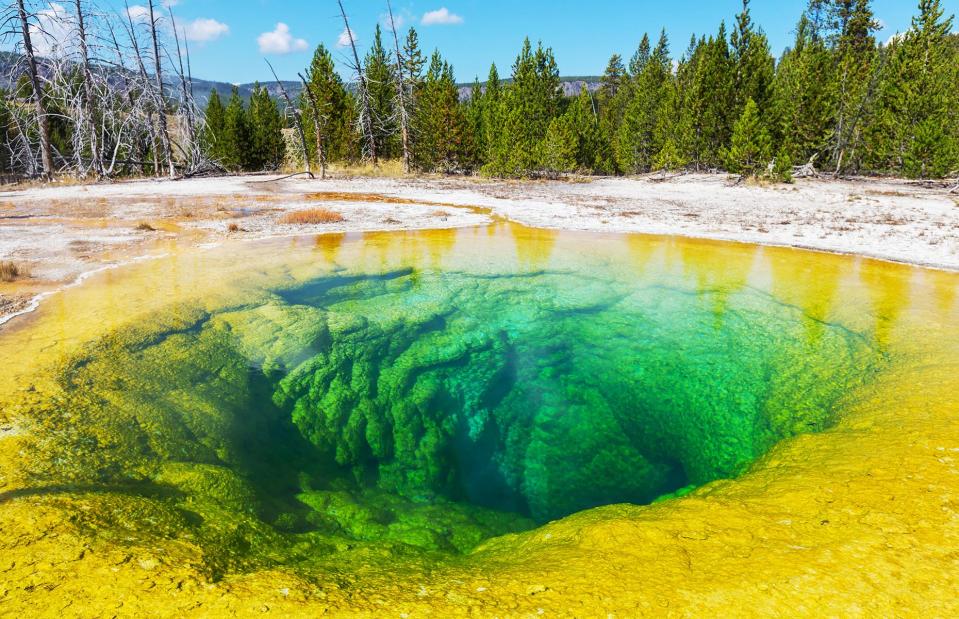
Galyna Andrushko/Shutterstock
Located in Yellowstone National Park's Upper Geyser Basin, Morning Glory Pool and its unique colour might be striking, but all is not what it seems. The pool was originally a bright blue colour, caused by bacteria that thrives in the hot water. However, after years of visitors throwing various objects into the pool, some of the thermal vents have been blocked, which has reduced the temperature of the water and the number of bacteria in it. Instead, invasive yellow-tinted bacteria continues to grow, creating a beautiful but sad rainbow appearance.
Skazka Canyon, Kyrgyzstan
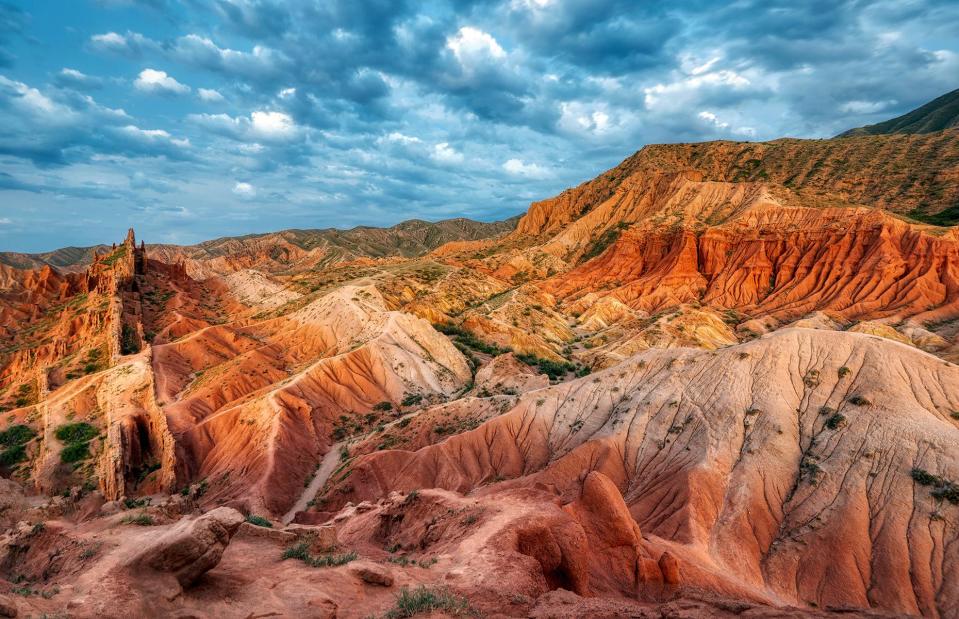
Lukas Bischoff Photograph/Shutterstock
Located in remote Kyrgyzstan, the name means 'fairy tale canyon' and, with its bright red rock formations and winding sandy passageways, it’s easy to see why. It's widely considered to be one of the most striking sights in this far-flung Central Asian country.
Okavango Delta, Botswana
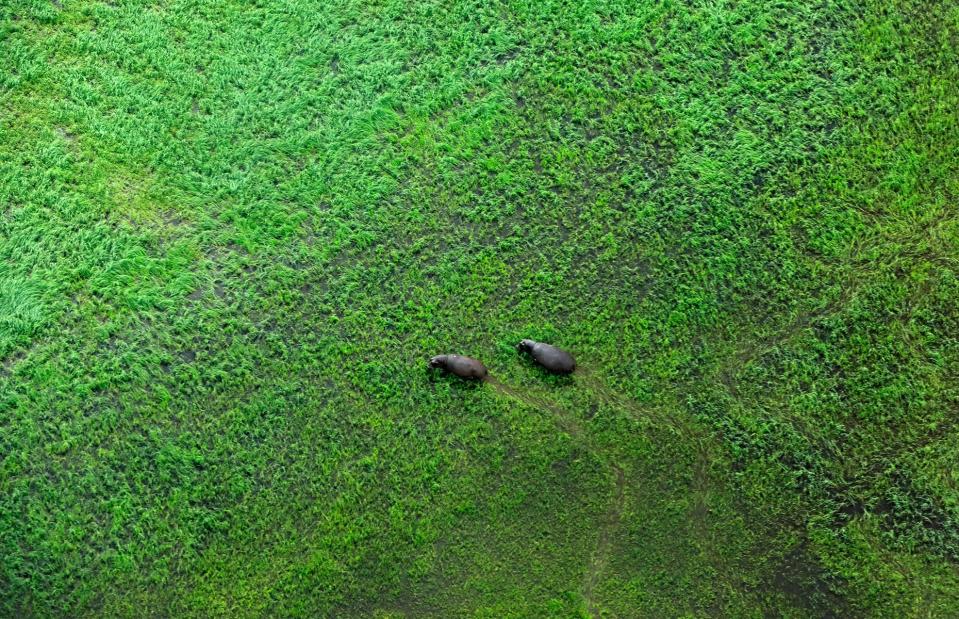
Ondrej Prosicky/Shutterstock
The Okavango Delta in Botswana is described as 'Africa's last Eden' – not too bold a claim given the unspoilt landscape and diverse wildlife of this sprawling lush green wetland area. The fluctuating delta is created as the Okavango River floods the Kalahari Desert, and is at its largest from March through to June. Some 160 species of mammal can be found within the delta area, from the African bush elephant to big cats like lions and cheetah.
Ningaloo Marine Park, Western Australia, Australia
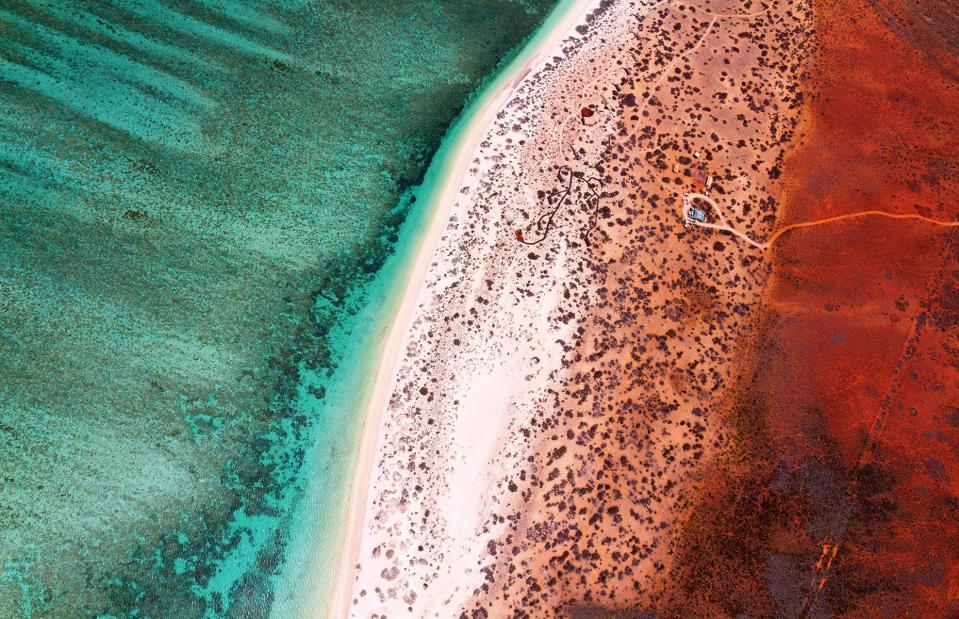
Darkydoors/Shutterstock
The Ningaloo Marine Park off the shores of Exmouth hugs more than 160 miles (257km) of Western Australia's coastline, and is home to more than 500 species of fish and 200 types of coral. From this bird's eye view you can see how the cyan waters meet the pale shores of Cape Range National Park, known for its sandy beaches, rugged gorges and orange rockscapes.
Colonia de Sant Jordi, Mallorca, Spain
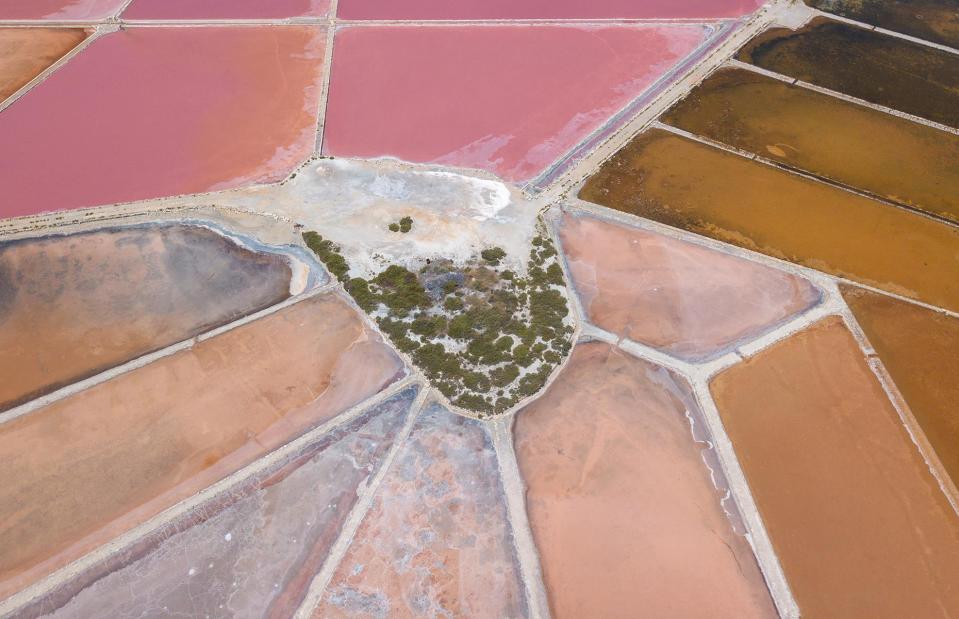
MC MEDIASTUDIO/Shutterstock
While it may look like a giant paint palette, this pink landscape is actually made up of salt flats and is situated in the seaside resort of Colonia de Sant Jordi in Mallorca's Ses Salines district. Salt is a major export here and a great source of local pride – a symbolic salt mound even appears on the area's coat of arms. The colours – earthy pink, deep tan and rich nude – pop when captured from up high.
Danakil Depression, Ethiopia
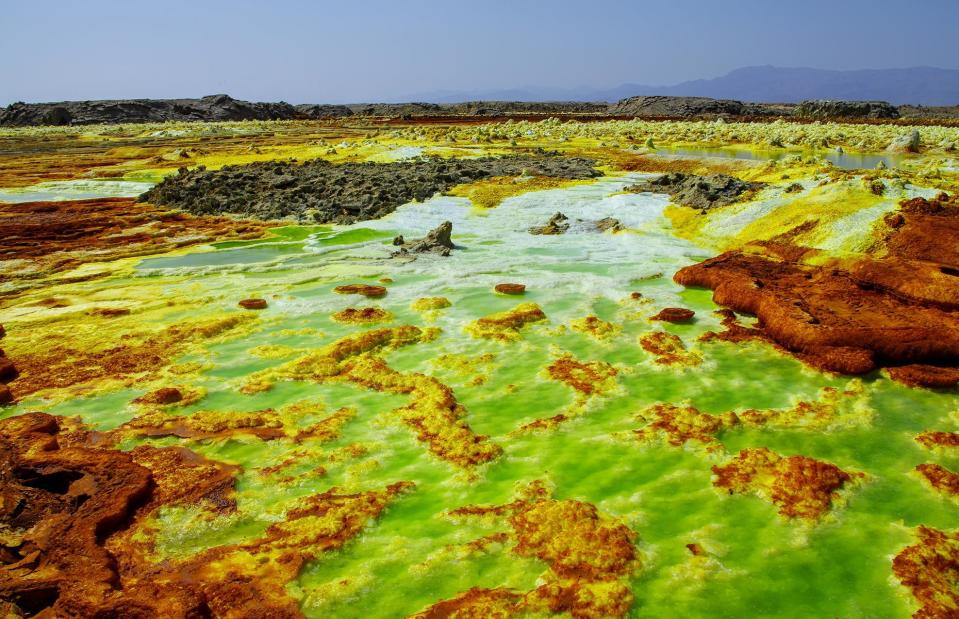
Tanguy de Saint-Cyr/Shutterstock
A result of the divergence of three tectonic plates, Ethiopia's Danakil Depression is a sight like no other. Here, steam spits out from openings in the Earth’s crust and chemicals released by the hot springs colour the rocky mineral deposits yellow, orange and green. This eerie lunar-like landscape of sulphur springs is also one of the hottest places on Earth.
Rainbow eucalyptus, Hawaii, USA
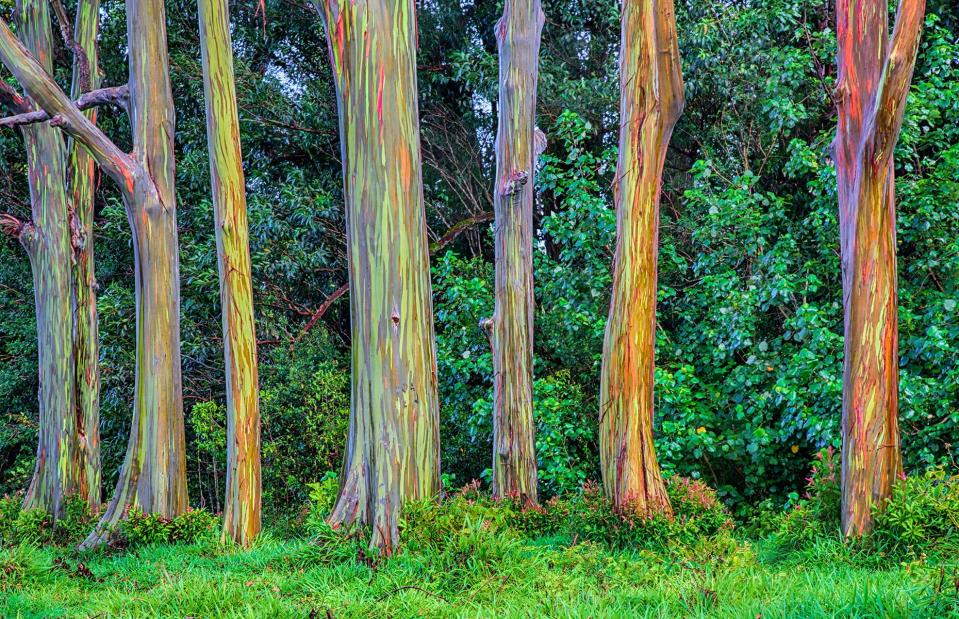
Danita Delmont/Shutterstock
These multicoloured trunks may look like something out of a film, but they're actually from the tropical shores of Hawaii. Also known as rainbow gum trees, the technicolour lines on these trees' trunks are down to different parts of the bark shedding at different times. On top of looking the part, these trees smell lovely too.
Geyzernoye Lake, Russia
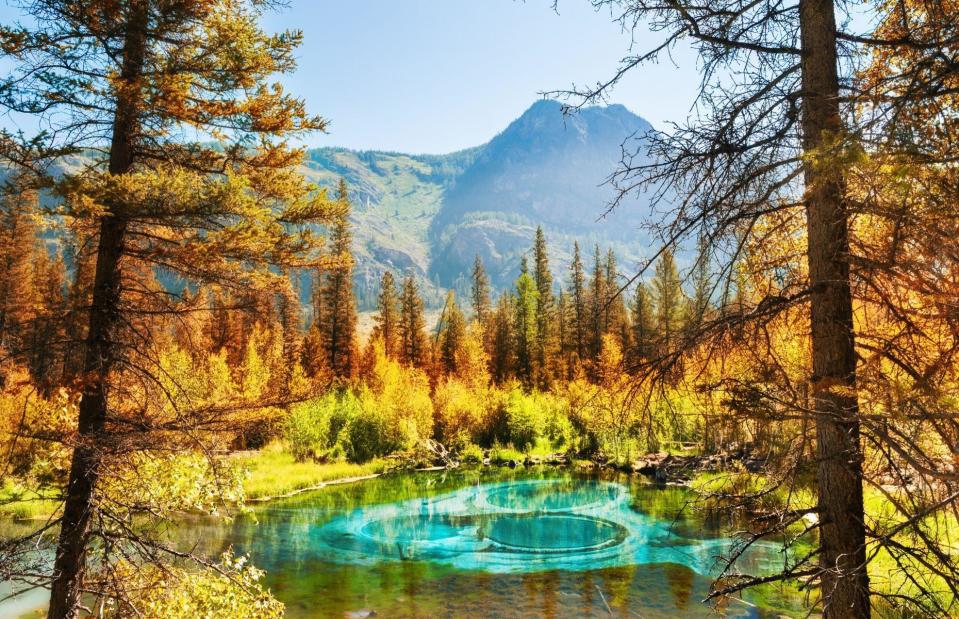
Olga Gavrilova/Shutterstock
Geyzernoye Lake, also known as Blue Lake, is located in the remote Altai Republic in Siberia. This spectacular thermal spring has vibrant teal waters where, every now and then, visible concentric circles appear beneath the surface, throwing out clay and sand in geyser-like eruptions.
Deadvlei, Namibia
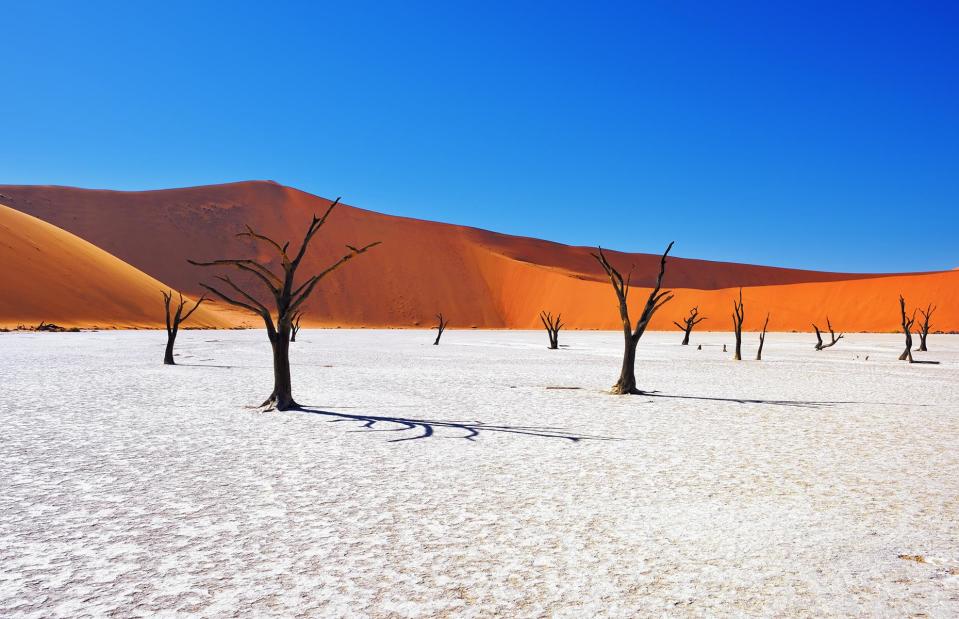
Oleg Znamenskiy/Shutterstock
This white salt pan, tucked within the Namib-Naukluft Park, is an otherworldly sight. Dotted with petrified trees and surrounded by rust-red dunes, the dry mineral pan of Deadvlei doesn't really look like anywhere else on Earth. The contrasting colours of this landscape are simply breathtaking.
Maple trees in autumn, Quebec, Canada
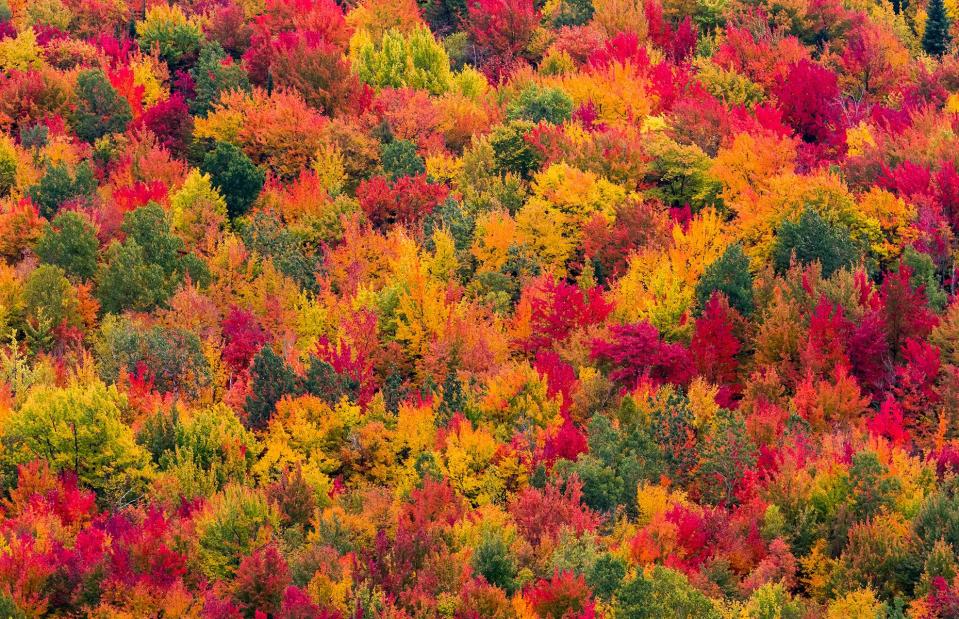
Pat Lauzon/Shutterstock
Autumn is a colourful season everywhere in Canada, but nowhere is it more so than in the province of Quebec, where maple trees are especially abundant. The leaves turn bright orange or brilliant red, covering the rolling, rural hills of the province in a blanket of colour for several weeks in October. The trees also have a sweet season in the early spring, when their sap is tapped and turned into delicious syrup.
The Wave, Arizona, USA
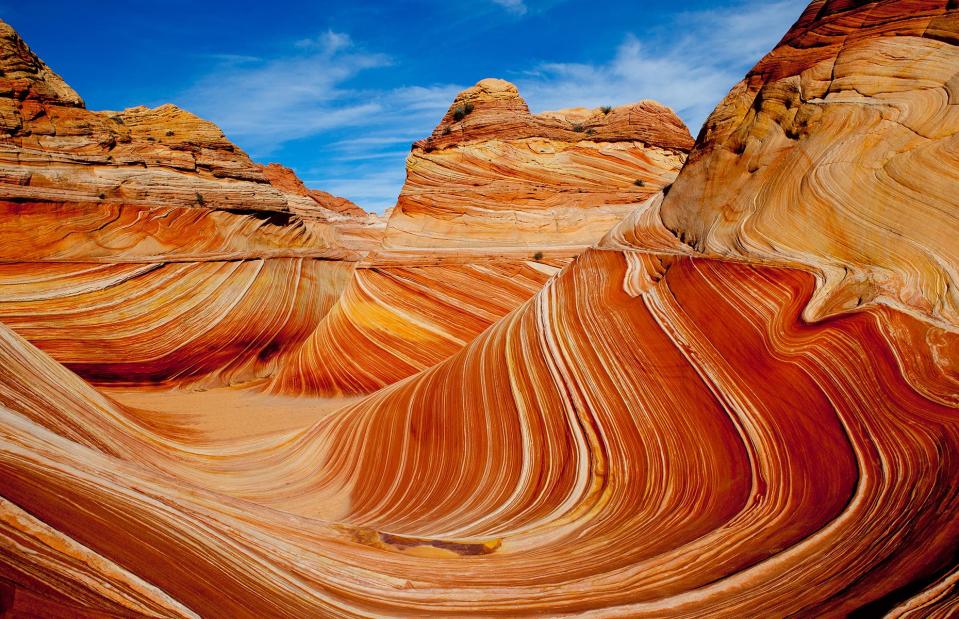
Tu Le/Shutterstock
One of the most mind-blowing rock formations in the States, the Wave is situated in the Coyote Buttes, pressed up against the Utah border. The dramatic sandstone landmark looks almost as if it was painted by hand, its face coloured with rippling bands of white, salmon and orange. It was formed millions of years ago, as sandwiched rocks were gradually eroded.
Xwejni Salt Pans, Gozo, Malta
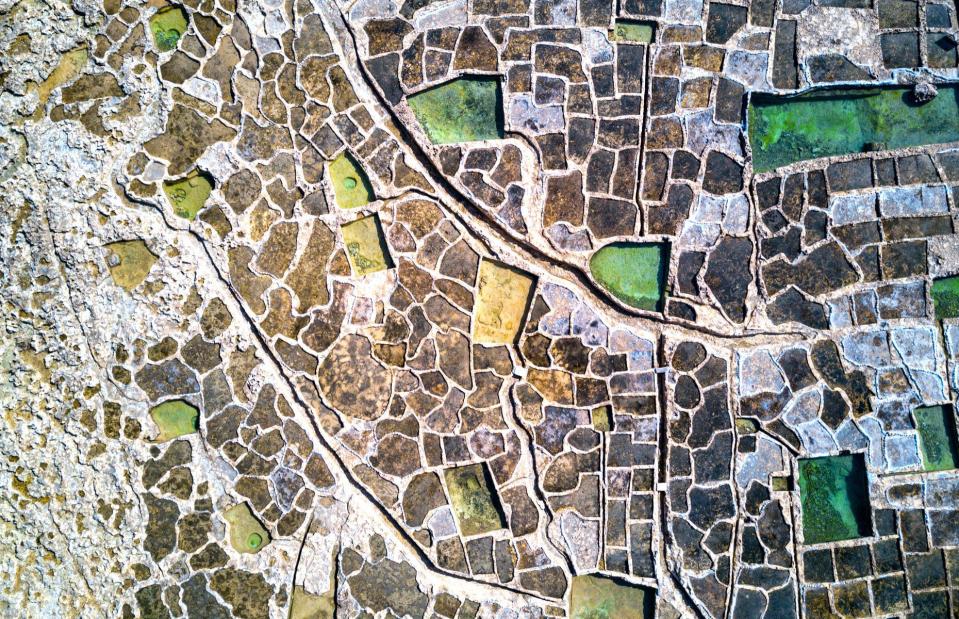
Nicholas Courtney/Shutterstock
The pretty Maltese island of Gozo is famous for its Neolithic sites and rugged stretches of coastline, but it's also notable for its salt production and in the north you'll find large clusters of salt pans. They're at their most picturesque when seen from above: the pans appear like a mosaic with hues of earth brown, white and sand punctured by emerald-green water.
Munnar, Kerala, India

Dmitry Rukhlenko/Shutterstock
High in the Western Ghats, this hill station and former resort for the upper echelons of the British Raj looks out over lush plantations and mist-covered hilltops. Dotted by tea estates, which were originally established by the Scottish, the green landscape here is simply breathtaking. The region is also famous for the elusive neelakurinji flowers, which only bloom every 12 years. The next event is due to happen in 2030.
Pink Beach, Komodo Island, Indonesia
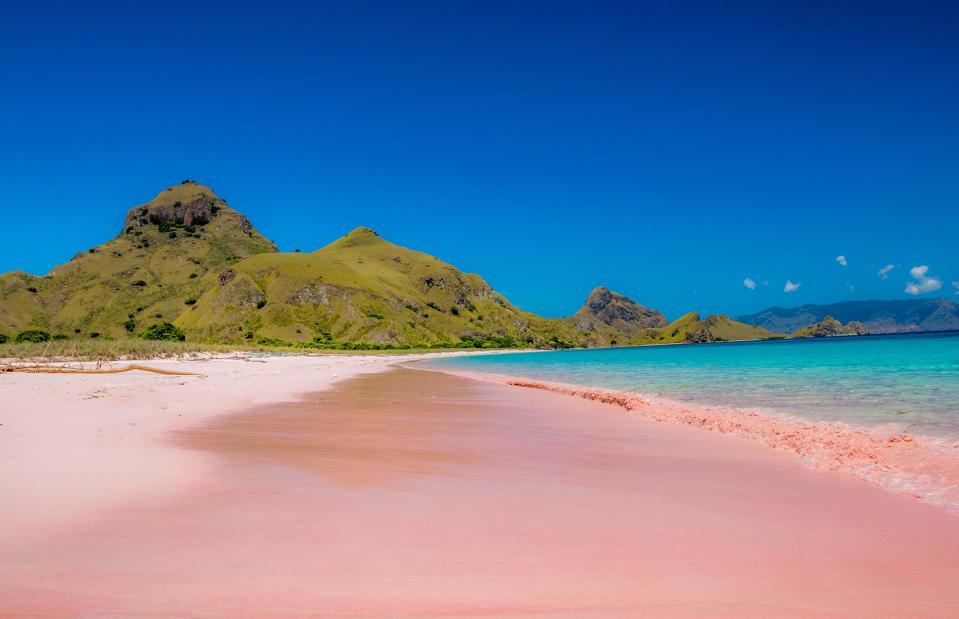
Pocholo Calapre/Shutterstock
There are thought to be just a handful of pink beaches in the world and one of the most famous (and most spectacular) can be found on Komodo Island in Indonesia. The beach's pastel hue is created when the red shells of tiny creatures called foraminifera combine with white sand. Sandwiched between crystalline waters and a rugged green landscape, this pink sand strip is almost too pretty to be real.
Northern Lights
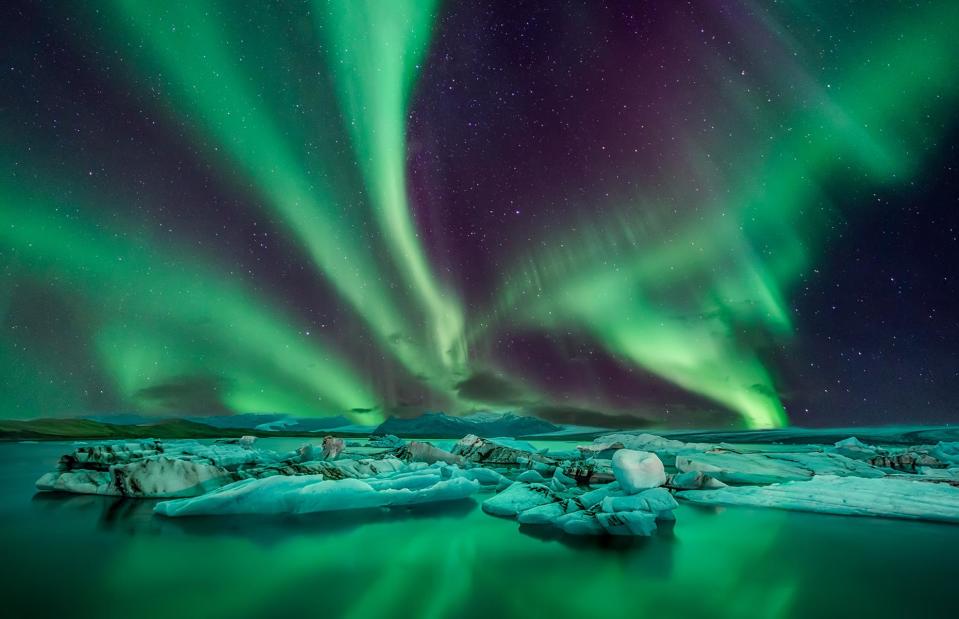
Ken Phung/Shutterstock
The Northern Lights, or aurora borealis, might not be found on the ground, but the natural light display deserves a mention thanks to its famously striking appearance. Although these majestic purple and green bands of light cover a wide geographical area, some of the most spectacular shows happen above Iceland, as seen in this image. Due to an extreme solar storm in early May 2024, the aurora was seen scattered far across the northern hemisphere, from Arizona to Vienna.
Southern Lights
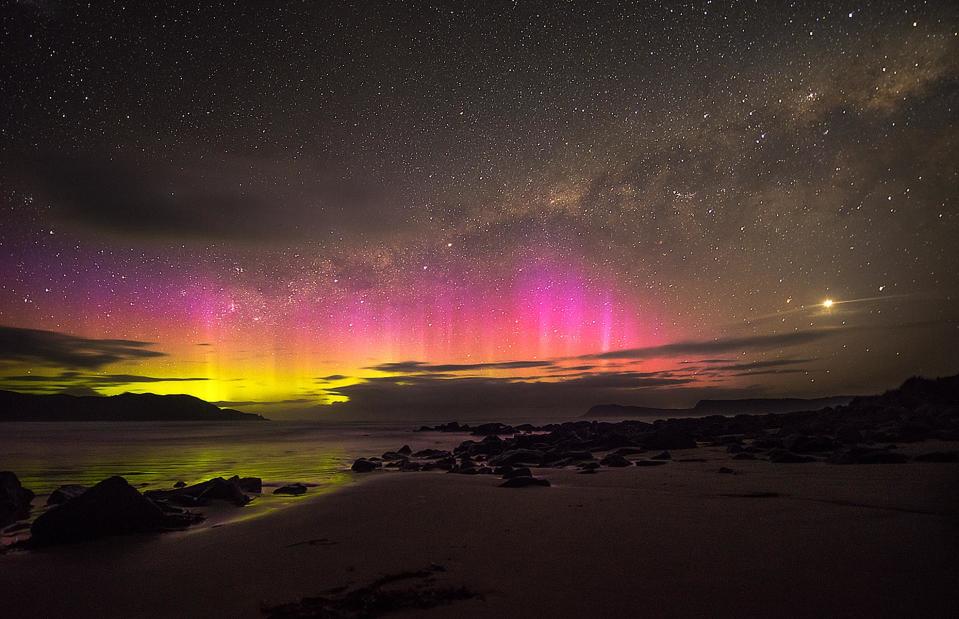
Stephanie Buechel/Shutterstock
Most people have heard of the Northern Lights, but the dazzling show offered in the southern hemisphere is almost as captivating. The aurora australis, or Southern Lights, is a dancing curtain of light that glows in every shade from pink to green. The result of energetic electrons colliding with atoms and molecules, this otherworldly show can be seen in Antarctica, New Zealand, southern Australia, Chile and South Africa.
Plitvice Lakes National Park, Croatia
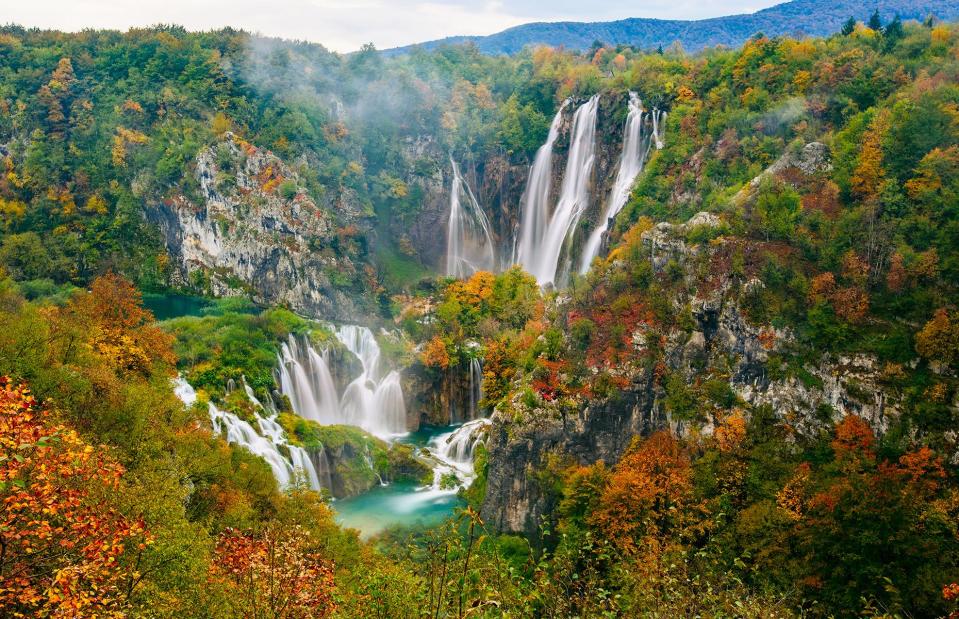
mpaniti/Shutterstock
Covering almost 115 square miles (298sq km), Plitvice Lakes National Park is found near the Bosnia and Herzegovina border, two hours' south by car from Zagreb in Croatia. The park, founded in 1949, is famous for its collection of 16 crystal clear, colour-changing lakes – they morph between shades of green and blue due to their high mineral content – plus over 90 waterfalls. It's a truly magical landscape.
Lake Natron, Tanzania
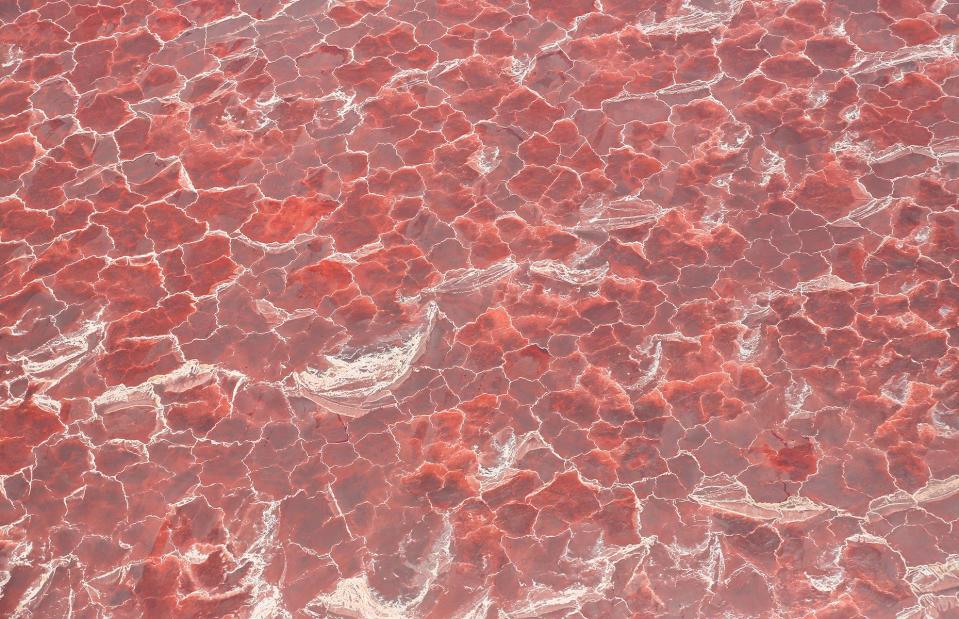
JordiStock/Shutterstock
This lake in northern Tanzania might look gorgeous but it's actually deadly – the pH balance of the water is enough to burn anything that's submerged in it. Funnily enough, it’s also the toxicity level that gives the lake its signature striking red, cracked appearance.
Havasu Falls, Arizona, USA
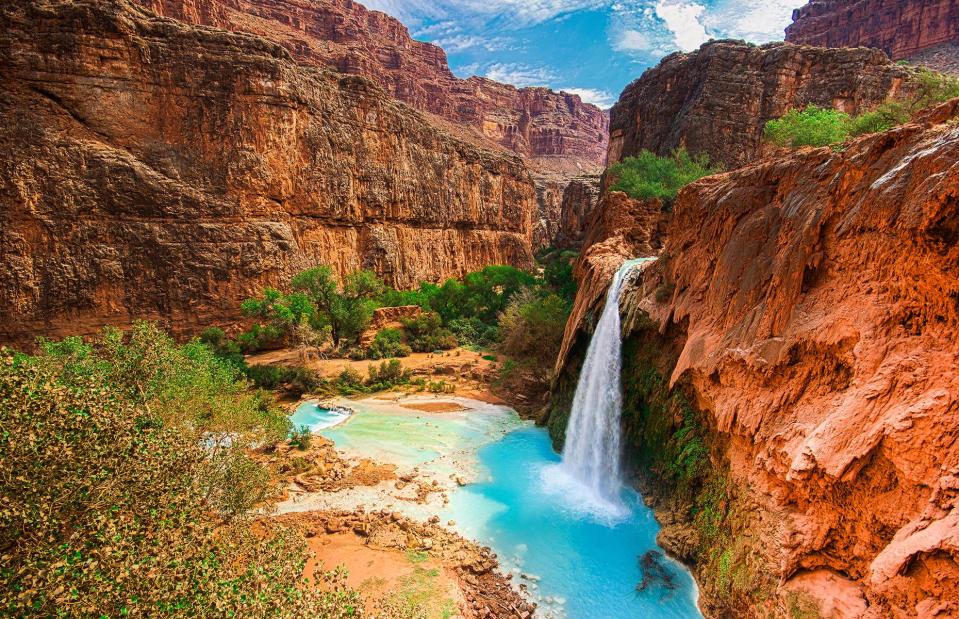
iacomino FRiMAGES/Shutterstock
The colours of Havasu Falls look otherworldly but this eye-popping combination of orange-pink rock and a pool of cerulean blue, fed by a silken cascade, is definitely real. One of five waterfalls on the Havasupai Reservation, within the Grand Canyon, the water owes its vibrant hue to calcium carbonate in the water.
Pamukkale, Turkey
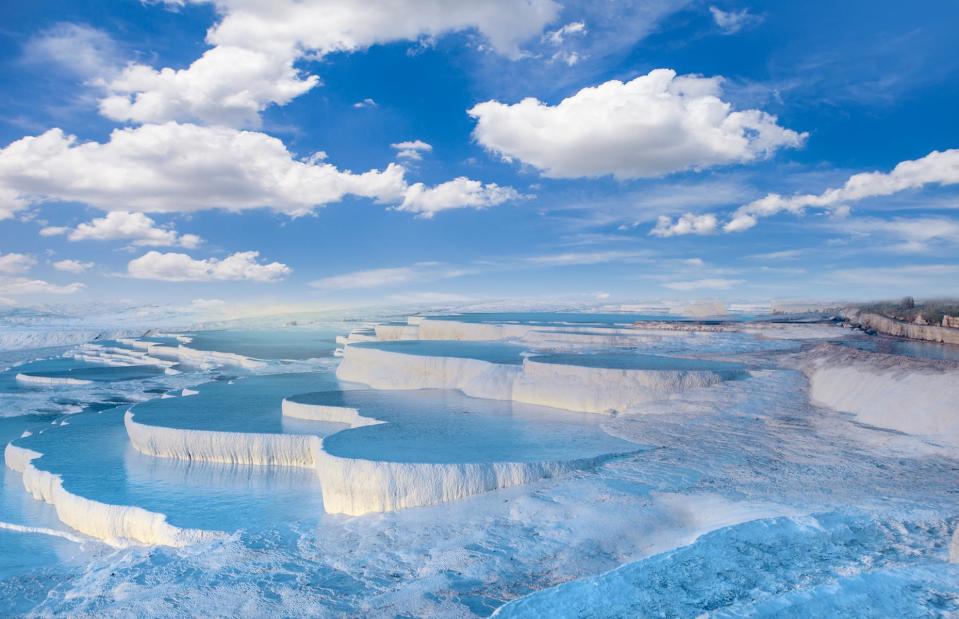
muratart/Shutterstock
One of Turkey’s most beautiful sights, the surreal travertine terraces of Pamukkale (meaning 'cotton castle' in Turkish) are a geological phenomenon. The striking pools are a result of the mineral-rich hot springs that bubble away beneath the ground.
Grand Prismatic Spring, Wyoming, USA
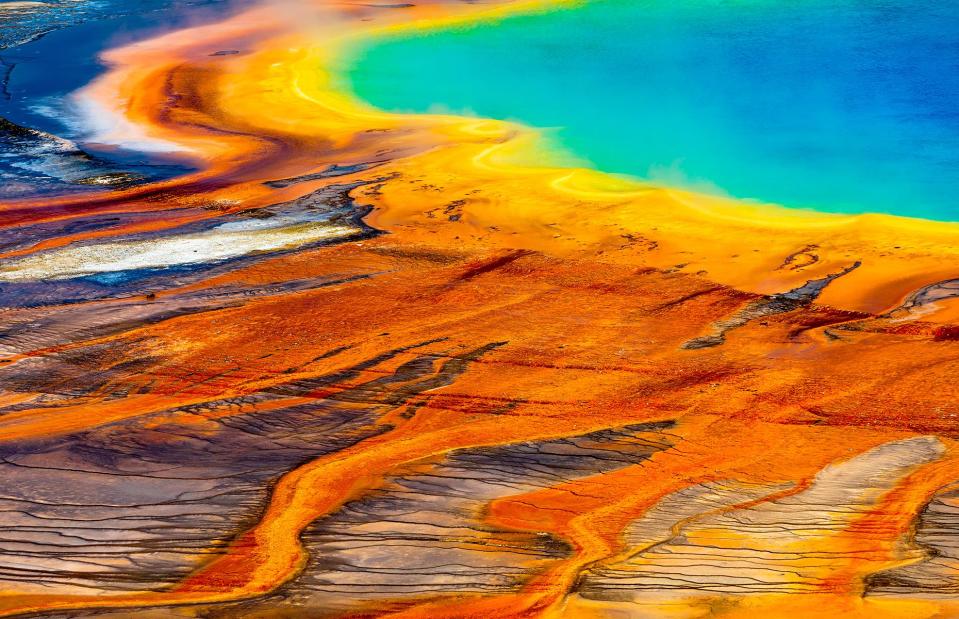
Anders Riishede/Shutterstock
Yellowstone's most famous hot spring, the Grand Prismatic's vivid blue centre is surrounded by bands of rusty orange, yellow and green, making it look otherworldly. The largest hot spring in the United States and the third largest in the world, Grand Prismatic's water reaches a temperature of around 70°C (160°F). Multi-layered sheets of microorganisms called microbial mats give the bands their distinctive colours that tend to change slightly with the seasons.
Mount Yoshino, Japan
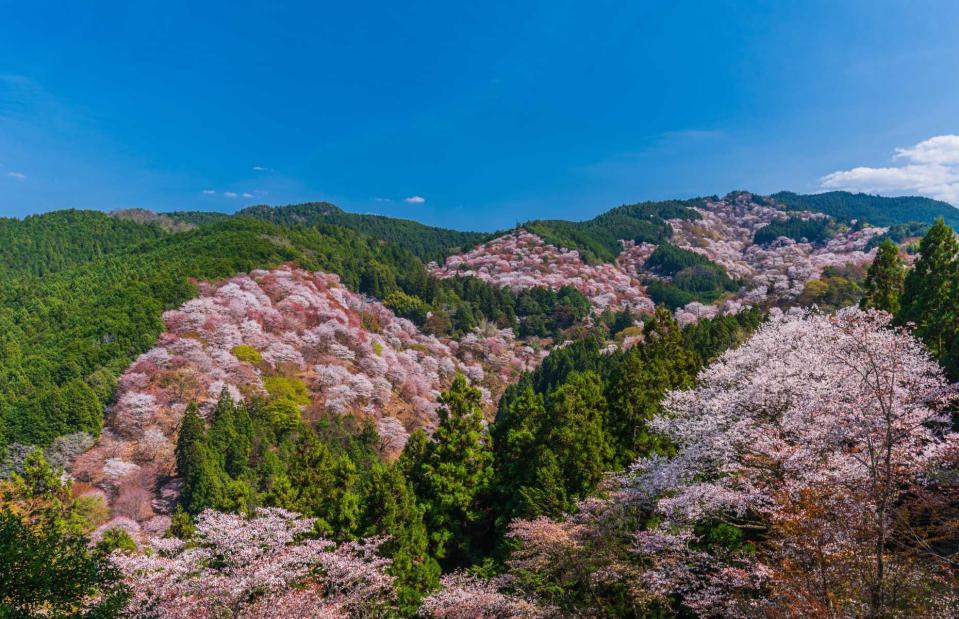
KazT/Shutterstock
At the beginning of April each year, the slopes of Mount Yoshino, or Yoshinoyama, burst into clouds of pink. This is when the sakura (cherry blossoms) make their highly anticipated annual appearance, with around 30,000 blush-coloured blooms decorating the otherwise green landscape. But this seasonal sight is more than just beautiful – it holds special significance within the unique spiritual tradition of Shugendo, which is rooted in mountain worship.
Waitomo Caves, North Island, New Zealand
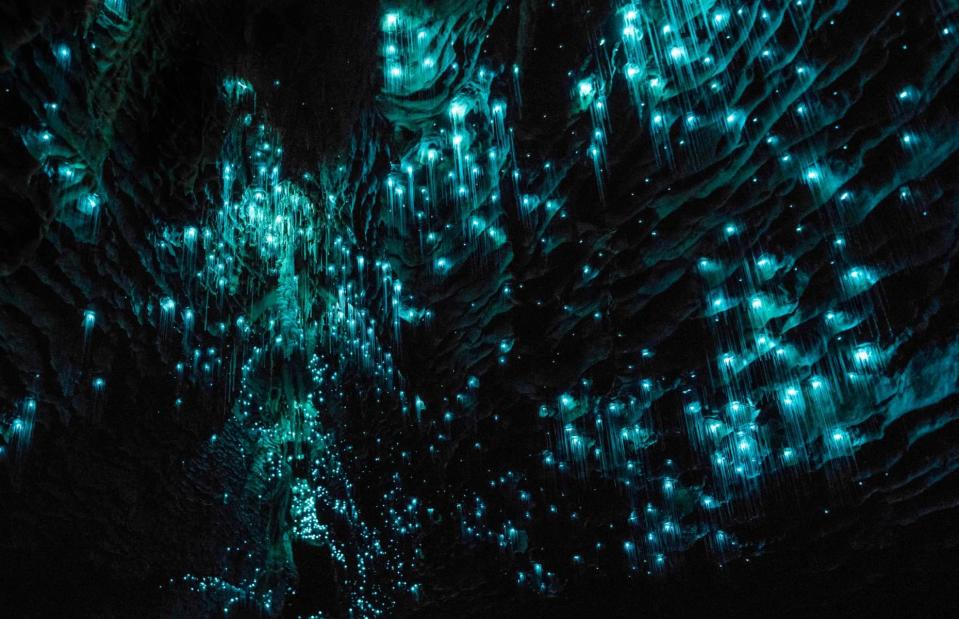
Shaun Jeffers/Shutterstock
This maze-like system of caves, cenotes and subterranean rivers is where many people come for black water rafting – a daring activity that involves scrambling, jumping, swimming and floating through the dark labyrinth on a rubber tube. But what really makes this one of New Zealand's finest natural wonders is the glowworm grotto, where you can take a boat ride under a canopy of thousands of blue-bottomed, luminous insects that dwell in the silent recesses of this underground sanctuary.
Now read on to discover 30 fascinating facts about New Zealand


